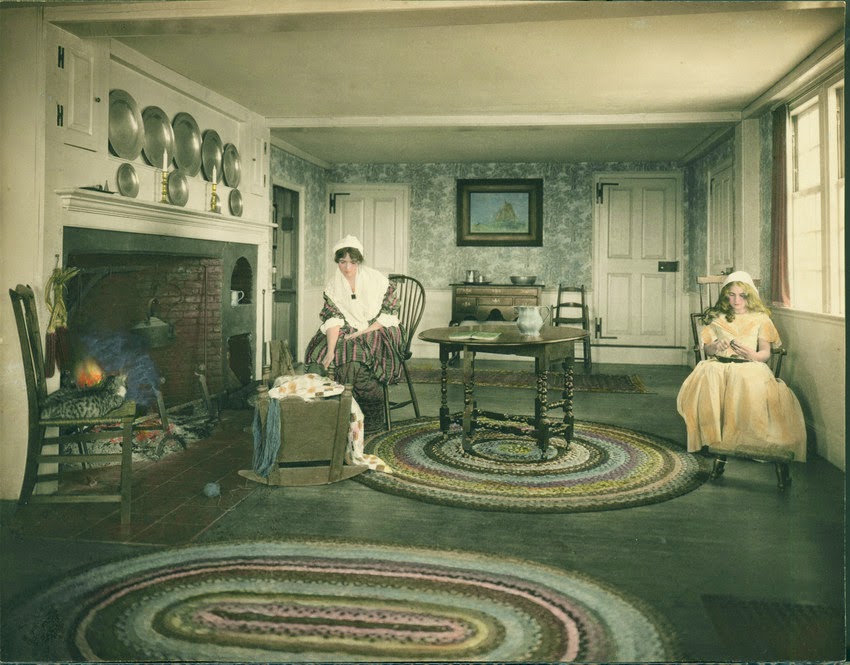He was in the changeless, legend-haunted city of Arkham, with its clustering gambrel roofs that sway and sag over attics where witches hid from the King’s men in the dark, olden years of the Province. Nor was any spot in that city more steeped in macabre memory than the gable room which harboured him – for it was this house and this room which had likewise harboured old Keziah Mason, whose flight from Salem Gaol at the last no one was ever able to explain.— H. P. Lovecraft, “The Dreams in the Witch-House”
 |
| H. P. Lovecraft in 1934 |
Today is Halloween, a day which we associate with ghosts and goblins and all manner of frightful things — including, yes, witches. Few have written so vividly about such horrors as H. P. Lovecraft. But what isn’t as well known is the common interest he shared with Alice Miner – that of America’s colonial era.
Howard Phillips Lovecraft was born in 1890 in Providence, Rhode Island. He lived in that city for most of his life, and he loved nothing more than the colonial buildings that in the early twentieth century still dominated much of the city. “I am above all scenic and architectural in my tastes” he explained to a friend. And with an exuberance he reserved for landscape and architecture, a Lovecraft stand-in returning after a long journey in “The Case of Charles Dexter Ward” described it thus:
At the high square where Broad, Weybosset, and Empire Streets join, he saw before and below him in the fire of sunset the pleasant, remembered houses and domes and steeples of the old town; and his head swam curiously as the vehicle rolled down to the terminal behind the Biltmore, bringing into view the great dome and soft, roof-pierced greenery of the ancient hill across the river, and the tall colonial spire of the First Baptist Church limned pink in the magic evening against the fresh springtime verdure of its precipitous background.
 |
| First Baptist Church, early 20th c. |
Lovecraft did not confine his interest in colonial landscapes to Providence. He traveled widely up and down the eastern half of the North American continent, from Key West in the south all the way to Quebec City in the north and as far west as New Orleans and Cleveland. Lovecraft was constantly writing on these trips. Letters to friends and travelogues both contained detailed descriptions and histories and even sketches of the architecture he viewed. These writings culminated in a 75,000-word opus on a single city, “A Description of the Town of Quebeck in New-France, Lately added to his Britannick Majesty’s Dominions.”
That title, with its purposefully archaic grammar and spelling, reflects Lovecraft’s wish to insert himself into the times and places he so romanticized. Unsurprisingly, then, Lovecraft strongly approved of the efforts to restore colonial buildings that took place throughout the Colonial Revival period. On a visit to Williamsburg, Virginia, he concluded “I must revisit Williamsburg when the restorations are compleat, perhaps two to five years hence. It will then form, without doubt, one of the most impressive evocations of the colonial past that America can display.”
 |
| Map of Arkham, Massachusetts, the fictional town where Lovecraft set many of his tales |
Lovecraft’s passion for colonial architecture would hardly be relevant to Halloween, were it not that those same colonial buildings were integral parts of his horror stories. Where the horror writers of the nineteenth century, from Shelley to Poe, used Gothic architecture to evoke an atmosphere of fear and gloom, Lovecraft used instead the familiar landscapes of his own New England.
 |
| The Crowninshield House in “The Thing on the Doorstep” was modeled on this house in Salem. |
One can’t read Lovecraft’s work without being shocked by his virulent racism. This racism was often symbolized in his work by architecture. The upright descendents of English settlers make their homes in stately colonial mansions or sturdy, well-kept farmhouses. In contrast, African-Americans, American Indians, or the “decayed branches” of white colonial families live in decrepit shacks or tenement houses.
 |
| The “Witch House” in Salem, home of Judge Jonathan Corwin in the 17th century. |
Yet the worst situation of all was when when a good colonial house was occupied by inferior peoples. In “The Dreams in the Witch-House,” the seventeenth-century building of the title has been rented to a motley collection of Italians, Poles, and even French-Canadians. When a college student with an old English colonial name, Walter Gilman, becomes fascinated by “the hushed Arkham whispers about Keziah’s persistent presence in the old house and the narrow streets,… about the childish cries heard near May-Eve, and Hallowmass” and takes a room, the tropes of horror fiction already suggest the ending.
Sources:
Evans, Timothy H. “A Last Defense against the Dark: Folklore, Horror, and the Uses of Tradition in the Works of H. P. Lovecraft.” Journal of Folklore Research 42, no. 1 (January 1, 2005): 99–135.
Lovecraft, H. P. Collected Essays, Volume 4: Travel. Edited by S. T Joshi. New York: Hippocampus Press, 2005.
Guides to visiting places that appear in Lovecraft’s work (if you dare):












